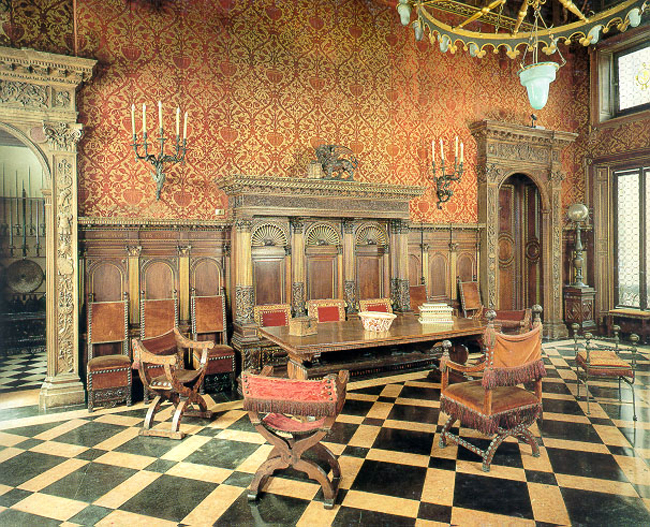
BAGATTI VALSECCHI MUSEUM - THE FLOWERS OF MURANO
GLASS OBJECTS, BERSELLINI COLLECTION, 1920-2010
11 MAY TO 8 JULY, 2012
Bagatti Valsecchi Museum: one of Europe’s most important & best preserved historic house museums.
Bagatti Valsecchi Museum, via Gesù 5, Milan, Italy – Grand Salon | ||
Located in chic downtown historic Milan, the Bagatti Valsecchi Museum is one of Europe’s most important and best preserved historic house museums. The home, a 16th century mansion purchased in the mid 18th century, was enlarged as the family grew in size and status. First in the Eclectic Style, in which styles were chosen based on the function of the rooms, the house was transformed into a "magic window" onto the Renaissance and the late 19th century when the brothers Barons Fausto and Giuseppe Bagatti Valsecchi took over the family home after their mother’s death in 1880. They redesigned the palazzo and its furnishings in the Neo-Renaissance style to celebrate centuries-old Lombard family roots, the then recently formed Italian nation and Milanese pride. Italian Renaissance arts and decorative arts collected by Fausto and Giuseppe at the end of the 19th century are displayed as they wished them to be seen: furnishings for the family mansion in which they wanted to live like Renaissance princes aided by modern comforts of the day, such as electricity and hot and cold running water, all masked to blend into this consciously unified environment that they designed. Paintings by Giovanni Bellini and his brother Gentile, Giampietrino—one of Leonardo da Vinci’s best and favorite pupils—Zenale and others are surrounded by Italian Renaissance frescoes, cassoni, tables, chairs, majolica, glass, metal and wooden objects and wooden revetment and ceilings, as well as arms and armor. Nineteenth century adaptations integrate them where necessary into a whole and the pieces are carefully inserted into a unified environment. Style magazines of the day cited the Bagatti Valsecchi Neo-Renaissance home as a prime example of good taste to follow. In 1974, the family donated their collections to a private non-profit foundation created to care for them and to share them with the public. At the same time, the family’s mansion was sold to the regional government with the proviso that this newly created Bagatti Valsecchi Museum should remain on the first (or "noble") floor in perpetuity: one strength of the collections remains, in fact, their authentic and indissoluble ties to the places where they were meant to be seen, creating not just a museum of individual pieces, but of entire ambiances expressing traditional late 19th century taste. In every room of the museum information cards are available in Italian, English, French, Spanish, German and Japanese. The use of audio-guides in Italian, English, French and Japanese is free with ticket purchase. Guided visits are available upon reservation in many languages. A small art shop offers mementos, many inspired by and created expressly for the museum. The temporary exhibit (closing 8 July 2012) dedicated to 20th century Venetian decorative glass arts remains true to the domestic nature of the museum while putting both the traditional and new in fresh relief. The museum, opened to the public in 1994, is easily reached by metro (lines 1, San Babila stop; 3, Montenapoleone stop), tram (1, Via Manzoni stop), and bus (54, 61, 73 , San Babila stop; 37, 94, Piazza Cavour stop). Nearby parking lots in Via San Pietro all'Orto and Via Marina. | ||
|
BAGATTI VALSECCHI MUSEUM
Museo Bagatti Valsecchi, via Gesù 5 - 20121 Milano, Italia
INFORMATION: • Phone: +39-02-7600-6132 • Website: http://www.museobagattivalsecchi.org • Fax: +39-02-7601-4859 • Mail : info@museobagattivalsecchi.org OPENING TIMES: Tuesday through Sunday, 1 P.M. to 5:45 P.M. Closed Mondays, public holidays and the month of August. Special opening hours may be reserved for school groups, or special events. ADMISSION PRICE: Regular admission E. 8; reduced admission E. 4
|
||

